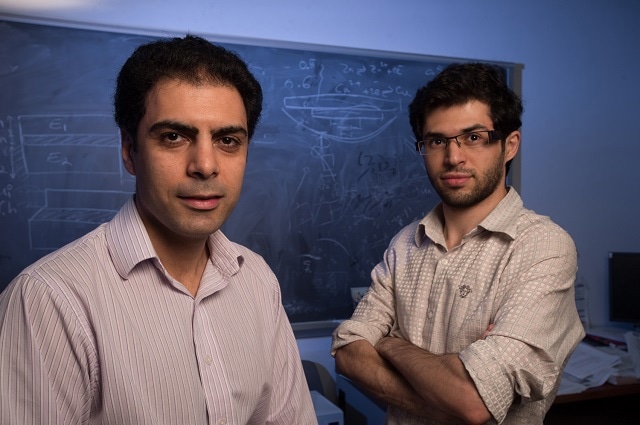
Rouzbeh Shahsavari, left, and Navid Sakhavand - Rice University - Image Credit - Jeff Fitlow
Nanoelectronics, composite materials and hydrogen fuel cells are just a few applications a new three dimensional porous nanostructure could make possible. Researchers from Rice University have made a computer simulation of the material by stacking extremely thin sheets of boron nitride in parallel layers.
The Simulation
The 3D structure is made by fusing together one-dimensional boron nitride nanotubes and two –dimensional sheets of boron nitride.
We combined the tubes and sheets together to make them three-dimensional, thus offering more functionality.
Rouzbeh Shahsavari, Assistant Professor of Nanoengineering at Rice University
The scientists were able to keep each of the layers apart by using tube-shaped pillars.
Shahsavari and his team noticed that the one-dimensional and two-dimensional versions had a bias in directional properties. The material either had a bias towards the tube axis or in plane directions which are not desirable characteristics for use in industrial applications.
A one-dimensional sample of boron nitride nanotubes can be stretched up to 20% of its overall length before a break occurs. However, during the simulation the 3D prototype was able to achieve up to 45% of its original length without breaking.
The team observed that when the one and two-dimensional boron nitride was stretched in one direction, they shank in other perpendicular directions. However, when the 3D material was stretched in the same direction it would also stretch in perpendicular directions.
Here, the junction between the tubes and sheets has a unique curve-like structure that contributes to this interesting phenomenon, known as the auxetic effect.
Rouzbeh Shahsavari, Assistant Professor of Nanoengineering at Rice University
Thermal Transport
Shahsavari and his team also notice another unique characteristic of the 3D nanomaterial. The one and two-dimensional boron nitride can carry heat very quickly in one direction, but the 3D prototype can carry heat in all 3D directions.
This feature is ideal for applications that require materials or coatings with extremely fast thermal diffusion to the environments. Examples include car engines or computer CPUs where a fast heat transfer to the environments is critical in proper functioning.
Rouzbeh Shahsavari, Assistant Professor of Nanoengineering at Rice University
The Material
The boron nitride nanostructure is porous, lightweight and an excellent electrical insulator. A single gram of the Swiss cheese-like structure has the equivalent surface area of three tennis courts. The researchers predict that the 3D nanomaterial could be used in efficient gas storage and separation similar to that found in hydrogen fuel cells.
The material also has the potential to support graphene based nanoelectronics, including the next generation of 3D semiconductors or 3D thermal transport devices.
What's Next?
We will have to wait and see the real world potential of this new nanomaterial as it yet to be created in the lab.
Shahsavari said "Our computer simulations show what properties can be expected from these structures and what the key factors are that control their functionality."
However, this material could soon offer a new way of storing hydrogen which may be powering the cars of tomorrow.
References